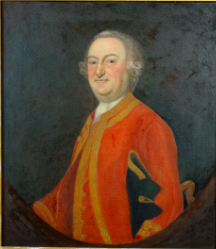John Winslow (British Army officer)
This article needs additional citations for verification. (April 2014) |


Major-General John Winslow (10 May 1703 – 17 April 1774), descendant of Edward Winslow, was an officer during the French and Indian War.
John Winslow belonged to one of the most prominent families of New England; his great-grandfather Edward and grandfather
In 1725, he married Mary Little, a descendant of Richard Warren. They had three children: Josiah, Pelham and Isaac Winslow. One of his slaves was Briton Hammon who published the Narrative of the Uncommon Suffering and Surprizing Deliverance of Briton Hammon, a Negro Man in 1760.[2]
After holding a few minor positions in Plymouth, he was commissioned captain of a provincial company in a failed British expedition to
.Seven Years War

In 1754, he was promoted major-general of militia by Governor William Shirley of Massachusetts and put in command of a force of 800 men which was sent to the Kennebec River in Maine to consolidate British positions and prevent French encroachments. There he built two forts, Fort Halifax (Maine) and Fort Western.
In 1755, he was appointed lieutenant-colonel of a
During the
He compiled a list of Acadian males deported that can be found at https://www.nosorigines.qc.ca/biography.aspx?at=h&id=19&lng=en
Winslow returned to Massachusetts in November 1755, but only a couple of months later he was appointed by Shirley (then temporary commander-in-chief), to command the provincial troops in an expedition against
In 1757 Winslow returned to Massachusetts and civilian life. He represented Marshfield in the General Court from 1757 to 1758 and from 1761 to 1765. In 1762 he served as a member of the St Croix River boundary commission, and in about 1766 he moved to Hingham, Massachusetts, where he died in 1774.
Legacy
The town of Winslow, Maine is named for General Winslow.[3]
Notes
- ^ Bryant, Maria Warren Whitman; Bryant, Herbert Pelham (19 August 2018). "Genealogy of Edward Winslow of the Mayflower, and his descendants, from 1620 to 1865". [New Bedford, Mass., E. Anthony & Sons, inc., Printers – via Internet Archive.
- ^ "Briton Hammon. A Narrative of the Uncommon Sufferings, and Surprizing Deliverance of Briton Hammon, a Negro Man,--Servant to General Winslow, of Marshfield, in New-England; Who Returned to Boston, After Having Been Absent Almost Thirteen Years. Containing". UNC University Library. Retrieved 21 October 2010.
- ^ Chadbourne, Ava H. (20 April 1949). "Many Maine towns bear names of military men". Lewiston Evening Journal. pp. A-7. Retrieved 17 October 2015.
References
- Winslow's Journal - Bay of Fundy Campaign (1755)
- Winslow's Journal - Battle of Beausejour
- Johnston, A.J.B.; Kerr, W.P. (2004). Grand-Pré, Heart of Acadie. Halifax: Nimbus Publishing. ISBN 978-1-55109-479-3.
- John Winslow's biography at the Dictionary of Canadian Biography Online
